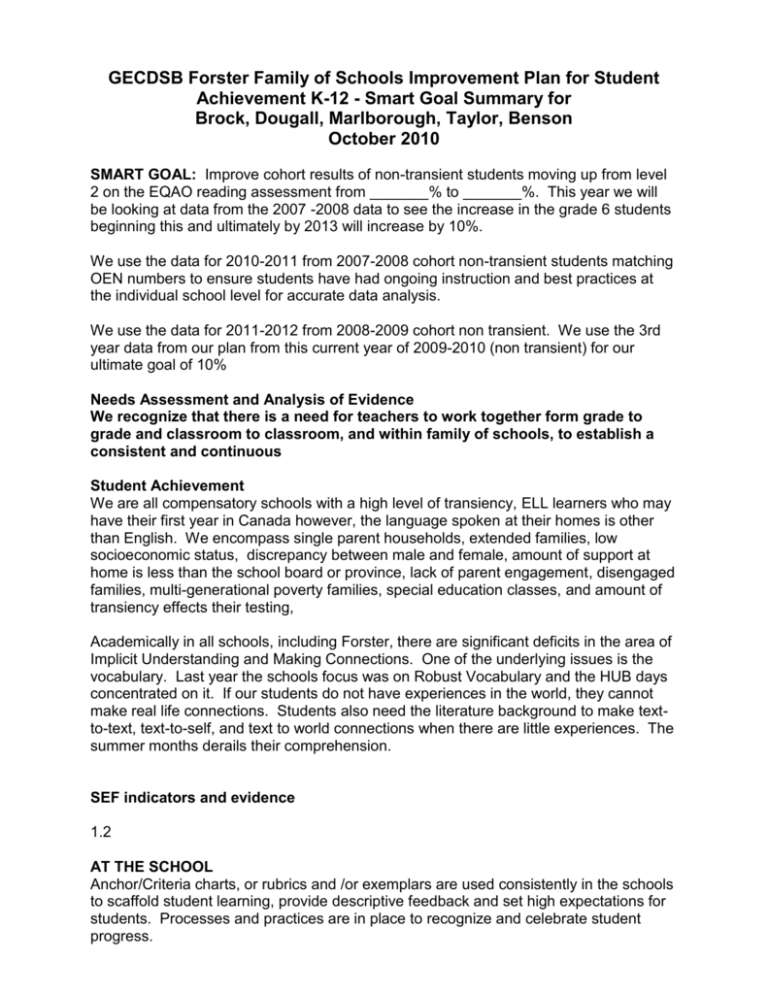GECDSB Forster Family of Schools Improvement Plan for Student
advertisement

GECDSB Forster Family of Schools Improvement Plan for Student Achievement K-12 - Smart Goal Summary for Brock, Dougall, Marlborough, Taylor, Benson October 2010 SMART GOAL: Improve cohort results of non-transient students moving up from level 2 on the EQAO reading assessment from _______% to _______%. This year we will be looking at data from the 2007 -2008 data to see the increase in the grade 6 students beginning this and ultimately by 2013 will increase by 10%. We use the data for 2010-2011 from 2007-2008 cohort non-transient students matching OEN numbers to ensure students have had ongoing instruction and best practices at the individual school level for accurate data analysis. We use the data for 2011-2012 from 2008-2009 cohort non transient. We use the 3rd year data from our plan from this current year of 2009-2010 (non transient) for our ultimate goal of 10% Needs Assessment and Analysis of Evidence We recognize that there is a need for teachers to work together form grade to grade and classroom to classroom, and within family of schools, to establish a consistent and continuous Student Achievement We are all compensatory schools with a high level of transiency, ELL learners who may have their first year in Canada however, the language spoken at their homes is other than English. We encompass single parent households, extended families, low socioeconomic status, discrepancy between male and female, amount of support at home is less than the school board or province, lack of parent engagement, disengaged families, multi-generational poverty families, special education classes, and amount of transiency effects their testing, Academically in all schools, including Forster, there are significant deficits in the area of Implicit Understanding and Making Connections. One of the underlying issues is the vocabulary. Last year the schools focus was on Robust Vocabulary and the HUB days concentrated on it. If our students do not have experiences in the world, they cannot make real life connections. Students also need the literature background to make textto-text, text-to-self, and text to world connections when there are little experiences. The summer months derails their comprehension. SEF indicators and evidence 1.2 AT THE SCHOOL Anchor/Criteria charts, or rubrics and /or exemplars are used consistently in the schools to scaffold student learning, provide descriptive feedback and set high expectations for students. Processes and practices are in place to recognize and celebrate student progress. IN THE CLASSROOM Interviews, conferences and learning conversations with small groups, pairs and/or individual students are used to clarify understanding of students' achievement of learning goals, throughout the lesson or unit of study. Ongoing feedback to students’ timely, explicit, constructive, and linked to success criteria to improve their learning Based on explicit, descriptive teacher feedback, students have multiple opportunities to revise and define their demonstrations of learning. Multiple opportunities for feedback and follow-up are planned at critical checkpoints in the learning. Feedback can be oral or written and should be descriptive rather than evaluative. STUDENTS WILL: Make explicit connections among content areas and between prior and current learning. Use success criteria,/rubrics/criteria, as a basis for discussion with peers and/or teachers to reflect on their progress and plan next steps. Provide constructive descriptive feedback to their classmates using assessment tools as the basis for discussion. #2 INDICATOR AT BROCK SCHOOL Instruction takes into account the background and experiences of all students and meets their diverse interests, aptitudes and special needs. IN THE CLASSROOM – Instructional decisions are formed by student interest, prior learning and learning style as well as by culture/language background, gender, and special educational needs Teaching-learning processes are organized so that there is a specific time set aside for activating prior knowledge, introducing new learning, reflecting on and consolidating what has been learned, followed by independent practice and application. Instruction models: How to verbalize thinking processes (e.g., think-alouds about making a plan, drawing conclusion and/or organizing thinking) How to make connections (e.g., sharing personal learning experiences related to the concept of strategy being taught) How to select appropriate thinking tools/strategies Engage in tasks that address the learning goal(s) of the lesson but may vary in sophistication in order to accommodate their learning needs. THE STUDENTS WILL Work in flexible groups with sufficient space for group work/recording (e.g., placemat thee use of manipulatives and technology, use student chalkboards, sticky notes to capture thinking, graphic organizers, chart paper) Share their learning from smaller working group(s) with the while class and wile doing so clarify and adjust their own thinking, make new connections and draw conclusions to summarize their thinking. RATIONALE This indicator is critical for the students at General Brock because of the extremely varied background of our population. Our students come from a variety of countries and cultures, from very recent immigrants to generational west-end families. Because of this, bringing in a diverse range of activities that targets the various needs of our learner is essential. As well, flexible groupings are key, since any given activity may need to be differentiated based on prior knowledge, interests, learning styles or cognitive level. This is apparent in the fact that in most of our classrooms, our students are constantly working in different groups based on the activity; in the future, we would like to see the same level of differentiation in all classes. #3 INDICATOR AT BROCK SCHOOL There are structures, processes and practices in place to guide decision making in the implementation and support of comprehensive literacy and numeracy programs for all students. IN THE CLASSROOM Assessments for learning (referred to as formative assessments) inform next steps for instructions. Practices include: Ongoing collection of formative information/data that verifies students’ strengths and weaknesses and determines the next steps in instruction and/or additional interventions Explicit, on going feedback based on predetermined criteria stated in a rubric, which helps students identify next steps Rubrics, with accompanying exemplars, which identify the expected quality of learning so that students may adapt and refine their work as they work toward demonstrating the provincial standard Anchor charts, co-created by teachers and students, which explicitly represent processes and strategies students need to use independently Early identification of struggling students in order to plan required interventions through intentional communication and collaborative planning Evidence-based strategies extrapolated from professional learning are used to differentiate instruction to meet the needs of all students. THE STUDENTS WILL Use criteria to set goals in order to continually improve their own learning Take ownership for actively engaging in the intended learning as individuals, in small groups and as a whole class. RATIONALE This indicator is key for school and classroom improvement. Assessments (both diagnostic and formative are used to drive teaching practice, most demonstrably through our TLCLP’s. Teachers also have bump it up walls in their classrooms, which provides a student-generated exemplar for all students to use and discuss. Most classes have anchor charts up, but not all are student-generated, which we can improve on. Classroom teachers working closely with the LST are quickly spotting struggling students through the use of regular progress monitoring and are jointly planning interventions. Professional learning through regular division-based PLC’s is imbedded during the school day. #4 INDICATOR AT BROCK SCHOOL Assessment practices which allow teachers and student to share responsibility for learning are in place. IN THE CLASSROOM Students refer to anchor charts, whether teacher developed or co-created by teachers and students, to help them understand what quality work looks like All assessment tools are in student-friendly language (e.g., checklists, samples of student work rubrics). Goal setting is modeled (e.g., think-alouds, anchor charts) STUDENTS WILL Ask for feedback from peers and teachers and use it to improve their work Rethink their ideas and strategies based on feedback from peers and teachers (e.g., using alternative computation and problem-solving strategies in mathematics, revising writing to meet the needs of the audience.) RATIONALE This indicator is critical for our students because it allows our students to take some ownership over and be invested in assessment practices. Modeling (whether through explicit instruction or use of anchor charts) is vital in order for our student to have a guide to what higher level responses look like/sound like. Bump it up walls take the practice of assessment/moderation and puts it in control of students, again to give them ownership of the process. Although anchor charts of some form are up in all classrooms, our staff for the most part are just beginning to use bump it up walls. Consistent use will hopefully drive improved quality of student responses. What are we looking for when we walk through? Targeted Evidence Based Strategies -establish a consistent and continuous framework for literacy improvement not limited to but including, 1) Common language and understanding of effective literacy instruction 2) Assessments that guides teachers' next steps to instruction 3) Opportunities for higher order thinking 4) Scaffolding deeper comprehension skills for students -Ongoing and continuous refinement and expansion of teachers use of Strategic Learning Plans/pathways as teachers plans how to explicitly match their instruction with specific students needs WE SEE continuous use of common assessments, DRA, CASI, DIBELS, EQAO...., baseline data and short, measurable (6-8 weeks) instructional cycles that ALL staff know -classrooms timetables contain all components of the literacy block, (read aloud, shared, guided and independent) AND ALL teachers know what it looks like and how to do it. -classroom timetables have time allotted for a writing block for shared or modeled writing instruction and independent writing. WE SEE timetables enlarged and posted in the classroom -teachers make reference to data walls of student progress as well as MISA data for the purpose of planning their pathways and instructional practices -teachers ensure consistency of vocabulary in the classroom WE SEE anchor charts, word walls, exemplars Bump It Up walls, feedback on work, rubrics for student learning skills and work habits, summary charts to show student thinking -teachers have Ministry documents and Guides to Effective Instruction as frameworks, access to Ministry Websites, pod casts, to assist consistency WE SEE teachers visiting other teachers classrooms, sharing in school expertise at PLC meetings, practicing strategies and comparing results in divisional meetings, PLC's and across Divisions and staff meetings. -Teachers take an inventory of the books in their classrooms and organize them WE SEE bins or areas of books sorted into levels for primary, as well as by themes and authors, fiction and non-fiction, books in multiple sets for student’s use (5-or 6) available and outdated books are purged -Early literacy opportunities in every aspect included in Early Learning classes also and every centre plan has an opportunity for kids to write and/or experience and experiment with literacy. WE SEE students at their various centres experimenting with pencils, paper, writing, reading, letters, sound etc. -teachers support improved student literacy by having a focus on higher order thinking skills (A Taxonomy of Higher Order Thinking Skills, p. 55-59, Guide to Effective Instruction in Literacy - 4-6) WE SEE/HEAR teachers posing questions to all level of students that promote metacognitive thinking during reading, writing, speaking and listening THINK ALOUDS -Teachers introduce and use comprehension strategies throughout their class WE SEE students and teachers building schema, making connections, inferring, questioning (BLOOMS HIGHER ORDER) and visualizing WE SEE students and teachers conferencing in during Independent Reading and Writing, teachers are providing students with quality feedback and we hear students able to identify their own progress and provide their own next steps following the teachers lead and modeling. (IE Bump it up wall - student at any time can be asked to go to the bump it up wall with a piece of their work and explain what level they are at and what they need to do to bring it up a level. This means that teachers AND students understand the rubric or assessment practice on that particular piece of work, the expectations and can place their work at the appropriate level). -teachers and all staff continue to explore boy’s literacy as a key priority in planning WE SEE various styles of print, genres in the classrooms including newspapers, instruction manuals, surveys on what the students like to read, a response to the survey by having the Liberian gather books for that particular grade of student) -teachers maintain a strong focus in all grade levels on ROBUST Vocabulary WE SEE teachers with robust vocabulary and activities in their classroom based on the professional book that all our schools participated in 2009-2010 - HUB, Bringing Words to Life. In order for our students to be able to relate and make connections, we need to bring the world to them. We found that there are vocabulary differences in specific words used on standard testing CASI, EQAO, DRA etc that are not part of the everyday vocabulary used by ELL students or our demographic population on a regular basis. Resources Thumbnail sketches, Guides to Effective Instruction, Growing Success, Fontas and Pinnell - The First 20 Days, The Daily Five, Robust Vocabulary, Literacy Coaches, SATL, Student Work Study, Professional Learning We need to learn to have consistency between schools and classes within the schools, divisions and grades. Our strategy to learn this in the school is to provide time for PLC's, professional development at staff meetings, regular walk-abouts to ensure consistency, HUB focus as a Family of schools (Implicit Understanding for reading) Progress Monitoring Walk throughs, check-ins, PLC's, monitoring pathways, informal conversations, class data as an indicator, report cards. Responsibility Admin planned PD, meetings with Area Principals on a monthly basis (breakfast and learn/share), LNST meetings, teachers, admin team, instructional coaches, Librarian, community, parents. Evaluation Cycle Using our Data wall (MISA) Compass for Success, HUBS, Principal meetings/dialogue among Forster Family of Schools Rationale We as a Forster Family of Schools are always flexible. We realize that this is a cycle and a process and that not all teachers are at the same place in practice. Our goals include a major change form the previous years...Principals meeting and sharing within the Forster Family of Schools on a regular basis, bringing data and feedback, progress monitoring our plan on a regular monthly basis. The logic behind this practice makes great sense when you consider the transiency of the student population and the idea that students move from one comp Ed to another comp Ed on a regular basis. If we are all on the same page, the consistency and expectations, the number of level 3 and 4 students will increase because we are all having these best practices modeled throughout our individual schools. We look forward to sharing with the world just WHY the WEST is the BEST!








